History of Taj Mahal
The origin of the name "Taj Mahal" is not clear. Court histories from Shah Jehan's reign only call it the rauza (tomb) of Mumtaz Mahal. It is generally believed that "Taj Mahal" (usually translated as either "Crown Palace" or "Crown of the Palace") is an abbreviated version of her name, Mumtaz Mahal.
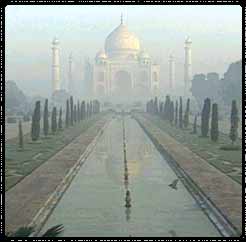 The construction of this marble masterpiece is credited to the Mughal emperor Shah Jahan who erected this mausoleum in the memory of his beloved wife, Arjumand Bano Begum, popularly known as Mumtaz Mahal, who died in AH 1040 (AD 1630). Her last wish to her husband was "to build a tomb in her memory such as the world had never seen before". Thus emperor Shah Jahan set about building this fairytale like marvel.
The construction of this marble masterpiece is credited to the Mughal emperor Shah Jahan who erected this mausoleum in the memory of his beloved wife, Arjumand Bano Begum, popularly known as Mumtaz Mahal, who died in AH 1040 (AD 1630). Her last wish to her husband was "to build a tomb in her memory such as the world had never seen before". Thus emperor Shah Jahan set about building this fairytale like marvel.
The construction of Taj Mahal was started in AD 1631 and completed at the end of 1648 AD. For seventeen years, twenty thousand workmen are said to be employed on it daily, for their accommodation a small town, named after the deceased empress-'Mumtazabad, now known as Taj Ganj, was built adjacent to it. Amanat Khan Shirazi was the calligrapher of Taj Mahal, his name occurs at the end of an inscription on one of the gates of the Taj. Poet Ghyasuddin had designed the verses on the tombstone, while Ismail Khan Afridi of Turkey was the dome maker. Muhammad Hanif was the superintendent of Masons. The designer of Taj Mahal was Ustad Ahmad Lahauri. The material was brought in from all over India and central Asia and it took a fleet of 1000 elephants to transport it to the site. The central dome is 187 feet high at the centre. Red sandstone was brought from Fatehpur Sikri, Jasper from Punjab, Jade and Crystal from China, Turquoise from Tibet, Lapis Lazuli and Sapphire from Sri Lanka, Coal and Cornelian from Arabia and diamonds from Panna. In all 28 kind of rare, semi precious and precious stones were used for inlay work in the Taj Mahal. The chief building material, the white marble was brought from the quarries of Makrana, in distt. Nagaur, Rajasthan.
HOW TO REACH TAJ MAHAL
BY AIR
Indian Airlines (Domestic Airline in India) runs daily flights from Delhi to Agra. Kheria Airport (Airport of Agra) is about 6 km from the Agra city centre and is easily accessible by taxis and auto-rickshaws at nominal rates.
Indian Airlines has two offices in Agra:
- Hotel Clarks Shiraz, Taj Road, Agra.
- Kheria Airport.
BY RAIL / TRAIN
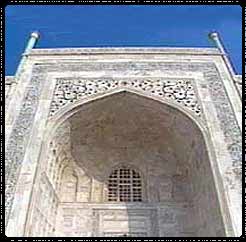 Agra is well connected by excellent train services to Delhi such as The Shatabdi Express (2 hrs), Taj Express (2.5 hrs), Intercity Express (3 hrs).
Agra is well connected by excellent train services to Delhi such as The Shatabdi Express (2 hrs), Taj Express (2.5 hrs), Intercity Express (3 hrs).
Railway Stations:
Agra Cantt Rly Stn, Enquiry: 131, 133. Reservation: 364611
Raja-ki-Mundi Rly Stn, Contact: 354477
Agra Fort Rly Stn, enbquiry: 132, 135 Reservation: 364131
BY ROAD -
Express bus services (a/c and non-a/c) are available from Delhi, Jaipur, Lucknow, Gwalior, and Jhansi. For those driving to Agra, the distances are:
- Mathura (Pilgrimage Destination) - 58 kms.
- Bharatpur (Bird Sanctury) - 60 kms.
- Gwalior (Historical Destination) - 118 kms
- Delhi (Capital City of India) - 203 kms
- Jaipur (Cultural & Historical Destination) - 236 kms.
- Khajuraho (Historical Destination) - 393 kms.
Taj Mahal - Building Aesthetics
Besides the miraculous architectural features and the elaborate ornamentation of the Taj Mahal, many additional features, which can often be overlooked, help complement and enhance this spectacular monument.
Background
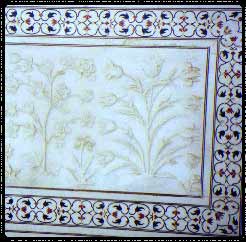 Unlike other Mughal tombs, the garden of the Taj Mahal has been laid out entirely in front of the tomb and does not play any part in the 'background'. Instead, the background has been provided by the sky. This background is not constant; it changes its colour and texture more than often, and the Taj is always presented in a variety of tints and moods. Its shades are subtly reflected on the white marble surface of the Taj Mahal which changes its colour and complexion accordingly.
Unlike other Mughal tombs, the garden of the Taj Mahal has been laid out entirely in front of the tomb and does not play any part in the 'background'. Instead, the background has been provided by the sky. This background is not constant; it changes its colour and texture more than often, and the Taj is always presented in a variety of tints and moods. Its shades are subtly reflected on the white marble surface of the Taj Mahal which changes its colour and complexion accordingly.
Marble
The Makrana marble used is of such a nature that it takes on incredibly subtle variations of tint and tone, according to the changes in the light, thus picturing the passing colour of the moment.
Forms and Lines
The composition of the forms and lines of the Taj Mahal is perfectly symmetrical. Here we meet with a beautiful admixture of lines, horizontal with vertical, and straight with curved - all harmoniously set together in the total unity. They adopt each other with amazing uniformity. The combination is entirely rhythmic and melodic. Especially the semi-octagonal alcoves at the chamfered angles which are perceptible from every perspective view and give a 3-dimensional appearance from the outset. They emphasise the diagonal lines and suggest depth.
Solids and Voids
The great depth has also been further suggested by the double arches, one over the other, on each side of the central portal. The solids and voids have very judiciously been distributed to provide a variety, yet an undiminished uniformity. These alcoves, the balconies in each minaret, the chhatris near the dome, and certain pronounced projections in each facade allow a beautiful play of light and shadow.
Soaring Effect
The colossal height of the tomb, along with its pyramidal appearance (which is obtained by the receding plinths, the square tomb and the bulbous dome, along with the pilasters surmounted by pinnacles, the tapering minarets and the decreasing volume of the dome culminating in a kalasa) give it a soaring effect. It appears as if it is about to rise into the sky...an ethereal quality full of lightness and grace.
Correction of Illusionary Effects
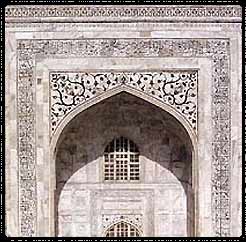 The indigenous builders of the Taj Mahal fully understood the deceptive nature of the human eye. They knew that the reality and its perception and interpretation thereof differed. The plinth of the main tomb is 2'10'' high on an average. But the height varies at different places, particularly the central point between two piers being in each case 0.5" to 0.7" higher than the sides. This convexity has deliberately been given to the plinth in the centre of each arch, or else the building would have appeared as if it were falling down! The facades are not exactly at a right angle with the plinth, but are slightly inclined. The finial is a stupendous crowning feature which measures nearly 10 meters!! The architect fully anticipated the apparent size which a finial would present from such a great height. It has therefore been very ingeniously been planned. These features of construction demonstrate the ability of the Indian architects to reconcile the illusionary effects created by distance and light.
The indigenous builders of the Taj Mahal fully understood the deceptive nature of the human eye. They knew that the reality and its perception and interpretation thereof differed. The plinth of the main tomb is 2'10'' high on an average. But the height varies at different places, particularly the central point between two piers being in each case 0.5" to 0.7" higher than the sides. This convexity has deliberately been given to the plinth in the centre of each arch, or else the building would have appeared as if it were falling down! The facades are not exactly at a right angle with the plinth, but are slightly inclined. The finial is a stupendous crowning feature which measures nearly 10 meters!! The architect fully anticipated the apparent size which a finial would present from such a great height. It has therefore been very ingeniously been planned. These features of construction demonstrate the ability of the Indian architects to reconcile the illusionary effects created by distance and light.
Fluted Pilasters
Sections in each facade have been demarcated by semi-octagonal pilasters that rise from the plinth of the main tomb. They have chevron patterns inlaid with black and yellow marble horizontally along their whole height. They appear to be fluted on each side though, as a matter of fact, there is no real fluting at all. They create a beautiful illusionary effect which the architect has very skilfully manipulated.
Uniform Size of Calligraphic Characters
The letter of the inscription around archways at the Taj Mahal, are generally supposed to become larger and larger above. On closer scrutiny, however, they are found to be of uniform size. Instead, the letters have been inscribed densely at the bottom, with little plain surface in between; the inscription becomes more and more sparse as it rises with more plain surface in between the letters. The diminution of the plain surfaces has been accurately calculated. Thus, the optical perspective of the letters has been reconciled, and unmistakable uniformity is obtained.
Excursions From Agra - The City of Taj Mahal
Bharatpur Bird Sanctuary
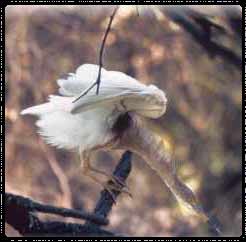 So great is the pull of the Keoladeo Ghana Bird Sanctuary, Bharatpur, that people spare not a thought for the state that gave birth to it. This superb waterfowl habitat, one of the finest in the world, was actually created by a maharaja. more...
So great is the pull of the Keoladeo Ghana Bird Sanctuary, Bharatpur, that people spare not a thought for the state that gave birth to it. This superb waterfowl habitat, one of the finest in the world, was actually created by a maharaja. more...
Delhi - The Capital of India
"The world is the body and Delhi its soul," wrote the poet Mirza Ghalib about the city he loved and lived in. And, as the soul is hard to describe, so is Delhi, this city with hundreds of years of history. more...
Gwalior
Situated in the state of Madhya Pradesh, Gwalior is the city of true royals, the Scindias. City is well known for its majestic fort, considered as one of the best in the world. Gwalior is located at a distance of only 118 km from Agra and well connected by road and rail. more...
Jaipur - The Pink City
Jaipur the capital city of the northern Indian state of Rajasthan is one of the most vibrant and colourful cities of India. Famous for its colourful culture, forts, palaces, and lakes the city basks in the glory of a rich and eventful past. more...
Mathura
Not far away from Agra, on the Delhi-Agra main line is located Mathura. The city is considered as the birthplace of Lord Krishna and the main point of Krishna circuit in the state of Uttar Pradesh. The city is an excellent day trip from Agra, which should not be missed by anyone interested in the religious heritage of India. more...
Vrindavan
South of Delhi, near the place of Krishna's birth, is the town of 4,000 temples where the sounds of celebration constantly resound. In the month of August, India celebrates the birth of Krishna, much as it has been doing every year for the past 5,000 years. more...